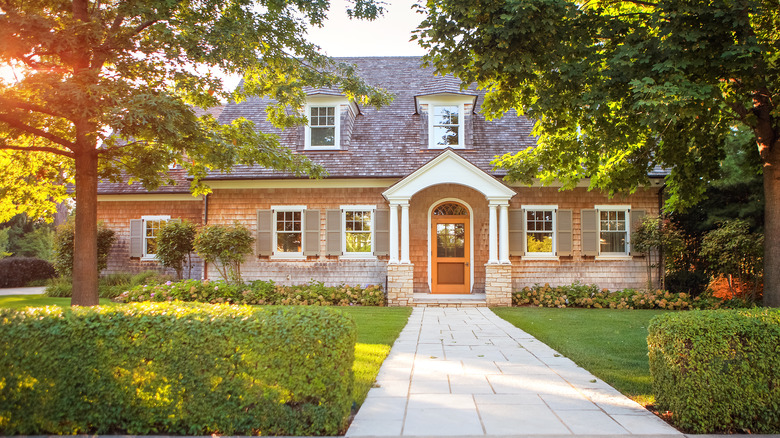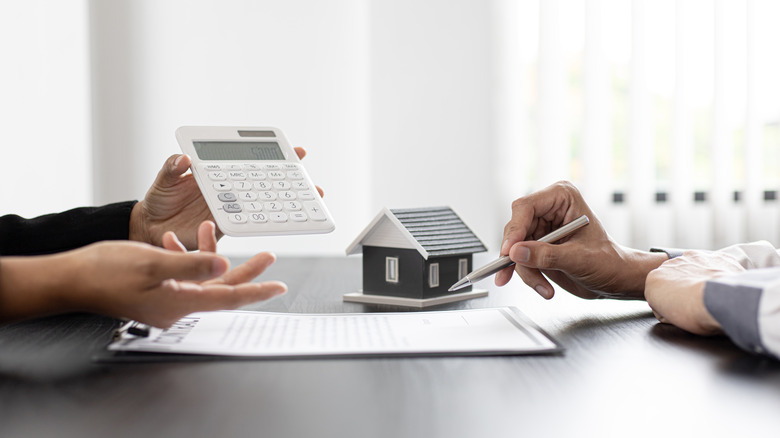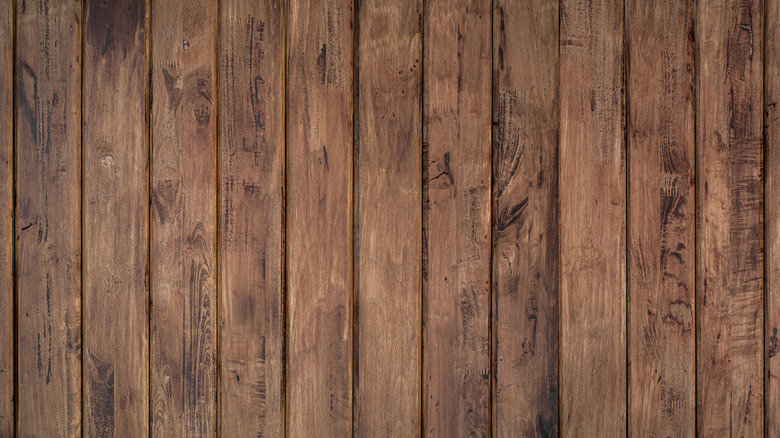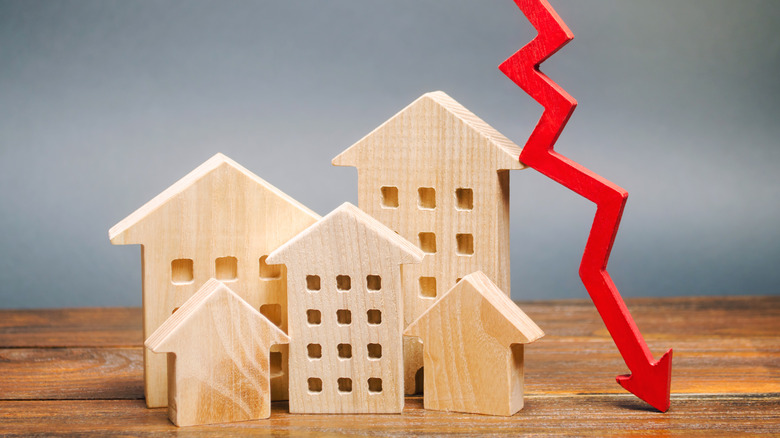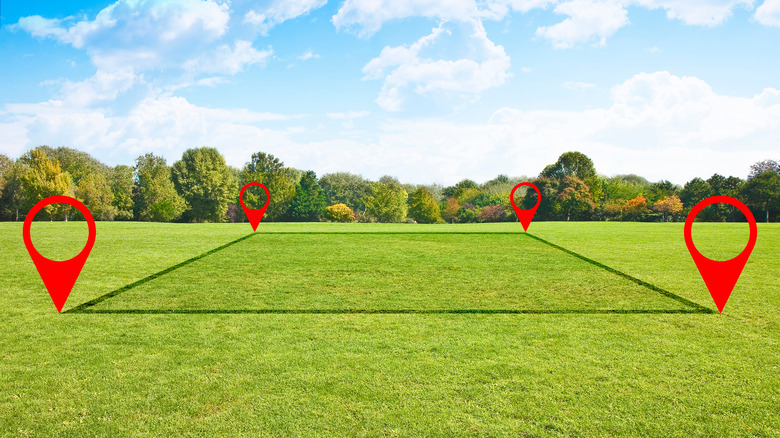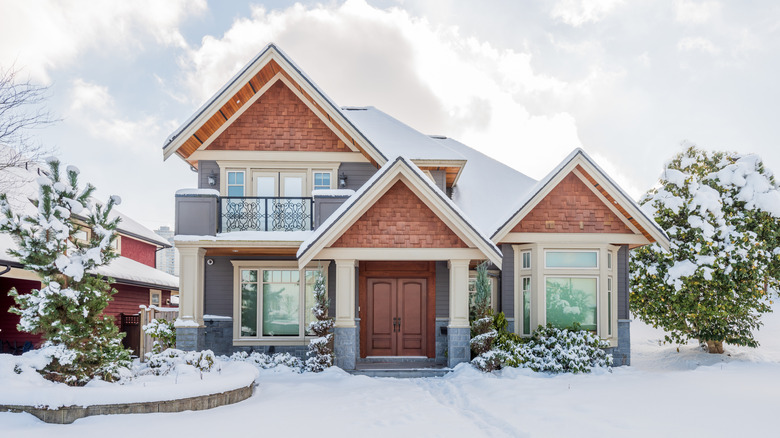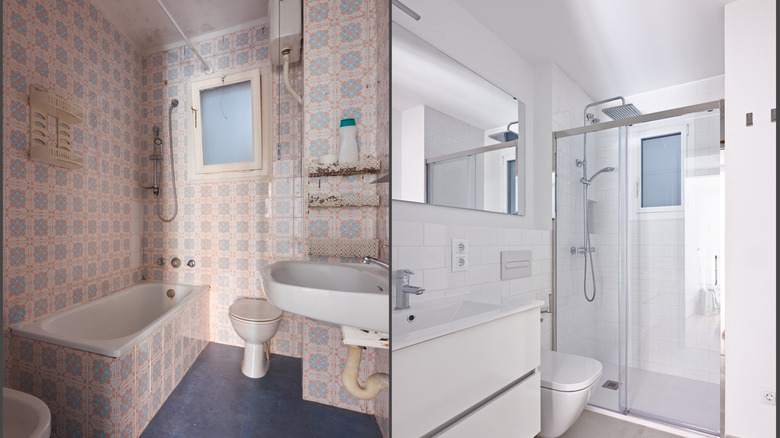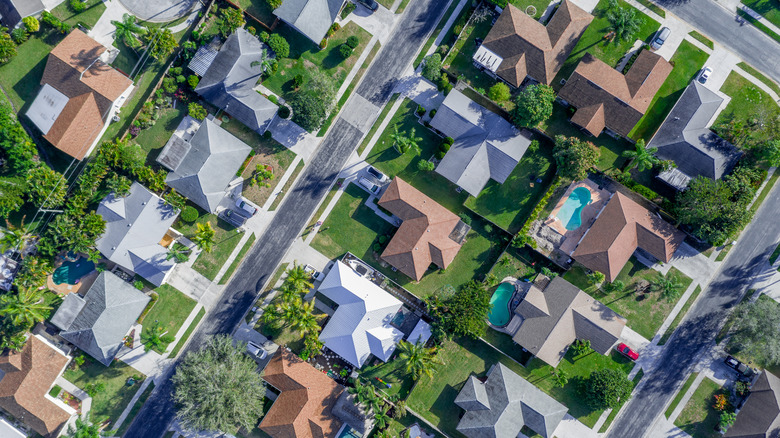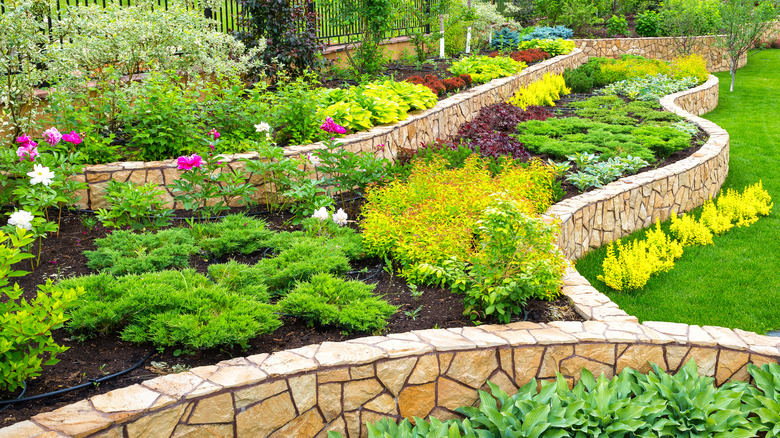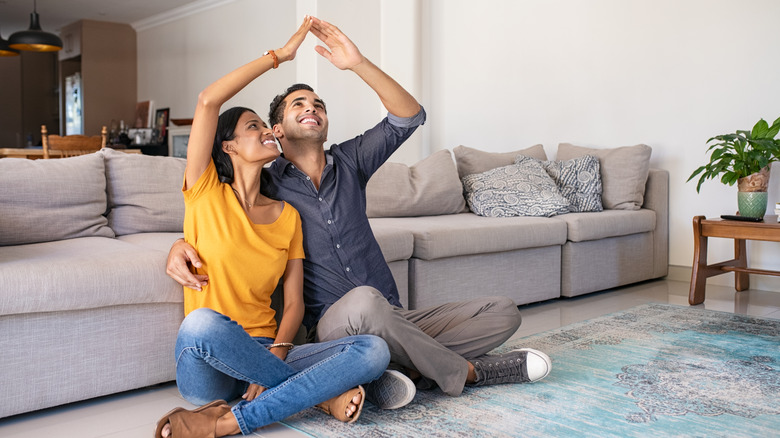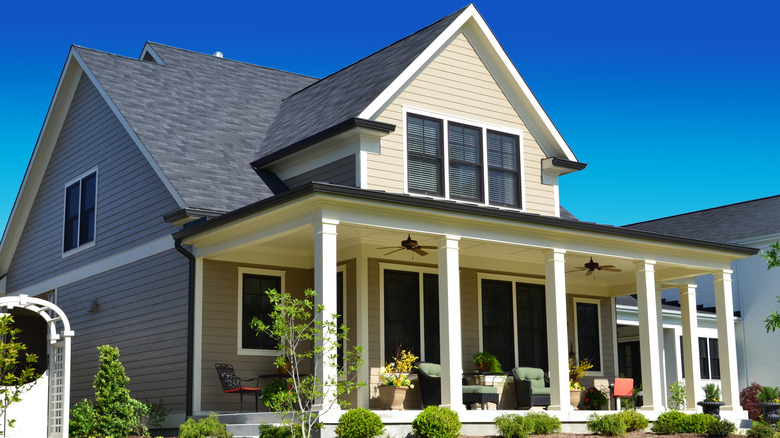The Benefits To Buying An Already Built Home
Buying a property is a regular odyssey of house hunting, paperwork, high-stakes decisions, and high-octane emotion, and that's before you even put your bags down in your new house for the first time. And sometimes, you just need to know what you're getting. This is where an already built home comes in, where, unlike new construction properties where you're buying something that may not even be made yet, an older, already built house is ready for you to step in and call it your own. And it seems like most people prefer it this way, according to a survey discussed by Property Industry Eye, which found that almost half of people would prefer to buy an old property, compared to just 21% of people who liked new construction homes.
Aside from practicalities, older homes just bring something new homes can't. Already built properties radiate history and charm. Let's face it, who doesn't love the allure of original beams, period masonry, and a fireplace older than your parents? Yet despite all this, some people still turn their noses up at older homes, and that's where we come in. We're here to persuade you otherwise by showing you all the benefits of buying an already built home.
An already built home's price will usually be better
Okay, so we don't mean to shock you with some totally brand-new information, but houses? They're pretty pricey. According to CNBC, the average home price in the U.S. in May 2021 was a whopping $329,522.56. But that number, which has risen steadily in the last few decades, is only set to get higher, projected to reach an eye-watering $382,000 by 2030.
Because of this, finding savings where you can is paramount, and that's where already built homes come in. Existing homes are traditionally much cheaper than new homes, with older homes coming in at almost $100,000 less than new homes in 2018 (via Realtor). And what's more, for that price, you're usually getting a lived-in property with charm to boot. While new homes might attract customers looking for up-to-date smart-home technology or trendy floor plans, they cost significantly more. Just think about what you could achieve in an older, cheaper house with savings like that.
Older homes come with enviable vintage features
While some people may favor sleek lines and all-new-everything in their homes, many of us prefer a little character in the places we live. And when you buy an already built home, you're getting just that: A house that was built for a different time that has distinctive, potentially one-of-a-kind vintage features. Older homes typically come decked out with features like protected porches and built-ins, which not only give your house a sense of personality but also provide ample opportunity for space and storage.
These vintage features may not only give a one-of-a-kind feel to your property but may also improve its resale value if you hold on to them. As Barbara Wells, owner of Connecticut-based Houlihan Lawrence real estate, tells Apartment Therapy, accents like embellished windows will always be a hit with people seeking a bit of older charm, and retaining them (despite the advantages of modern double-glazing) could help the house's resale value. Plus, vintage features can often be cheaper to repair than to replace. "When you find old wood floors, 99 percent of the time [they] can be repaired for cheaper than re-flooring," Nikki Holmes of Gold Rush Realty said.
There's more availability for already built homes
Housing in America is facing a bit of a crisis, which becomes particularly clear when you look at the new construction market. The problem, Danushka Nanayakkara-Skillington, assistant vice president for forecasting and analysis at the National Association of Home Builders, tells Insider, lies with "housing production not being able to meet buyer demand." This results in a massive squeeze on new housing in particular, with buyers racing to snap up new properties, often before they're even built.
This is why you may be better off seeking out an already built home. With such a push on new housing, you have more options looking for an already built property. And while you may still be competing with other house hunters, you get to avoid the wild competition that comes with new constructions and instead focus your attention on how you could make an older home your very own.
There's less time to wait before moving into your home
Okay, can we get a show of hands for people who like waiting? Anybody? No? Cool, that's what we thought. The fact of the matter is, no one likes waiting for stuff, but when you're buying a new construction property, that's exactly what you'll have to do. And honestly, sometimes that waiting period is pretty long. According to Zillow, depending on the project's stage, when you sign on a new construction home (or if you're designing a custom home), you could wait for months before your property is ready to move into. In fact, if you're buying before the building has even started, it could be six months or longer, according to Moving.com.
Now, we don't know about you, but we prefer our moves to happen a little quicker than that. And with an older property, that's exactly what you'll get. Granted, closing on a house is by no means an overnight process. According to House Logic, the closing process of house buying takes 50 days on average. But when the place already exists, you can be sure it'll be quicker to move into than waiting for it to be built. And in the meantime, you can spend your time planning all of the ways you can accentuate the classic features of the property with some seriously gorgeous design.
Already built homes usually have bigger lots
We're fairly certain that most people would prefer a little more space around their homes. Unless, of course, you're a celebrity with a mega-mansion, in which case, got any square footage you'd like to send our way? But unfortunately, new-build houses tend to veer towards the smaller side. In terms of lot size, that is. According to the Board of Governors of the Federal Reserve System, a shift seemed to occur in the U.S. in the late 20th and early 21st century that saw an increase in the average house's square footage but a decrease in its lot size. In fact, the lots diminished in size quite considerably, by over 20% on average in some communities.
This change could be down to several factors, from zoning regulations to increased population density. But what it likely means is that, as more space continues to be snapped up for new construction homes, new properties will increasingly find themselves situated on smaller lots. In contrast, already built and older properties may well come with much more land. And whether you use that space to create a killer garden or home addition, it's hard to put a price on the option of more space.
Older houses have a more visible purchase history
Buying a home usually comes with some level of risk, whether it be taking a gamble on a new area, or putting your trust in a home inspector to ensure the house is up to scratch. But when it comes to a new construction home, the risks are arguably even higher. You have to place your trust in a construction company, their timetable, and gamble if you'll even like the house once it's built.
In addition to that, you'll have to trust that the house will appreciate, which can be hard to prove without a purchase history. However, according to Rocket Mortgage, there are usually lengthy purchase histories attached to older homes. Robert Dietz, the chief economist at the National Association of Home Builders, tells Realtor that purchase and price history acts as a useful benchmark to track a home's potential to gain value over time. Not only that, but a purchase history allows you to track how many times your home has changed hands and can give you a sense of security that a house is worth the price based on how long people have stayed in the property.
Your property taxes could be lower
There will be a lot of extra costs involved with any property purchase, but there's one that pretty much everyone loathes: The dreaded property tax. But it appears that, until pigs fly, property tax is a fact of life, so the question then becomes, how can you reduce it as much as possible?
Well, buying an already built home is a pretty good start. As Million Acres discusses, older homes generally have a good chance of coming with lower property tax, thanks to the fact that older houses tend to be cheaper than new construction homes, and property tax works proportionally to the price of a property. A cheaper place equals cheaper tax. We love everything about that. It's important to remember, though, that the property's age shouldn't sway your decision beyond price, as there's no inherent difference between property tax for old and new houses specifically. As Gary Q. Michel, tax department chair at law firm Ervin Cohen & Jessup, tells Mansion Global, "What drives the property tax bill is the fair market value of the home purchased ... It is irrelevant that one home is newer than the other."
Older houses can be better constructed
Have you ever wondered why some houses just seem to stick around forever? Well, most of the time, you can mark that up to premium craftsmanship, care, and construction that went into many older homes. As Realtor discusses, older and more established homes were built with longevity in mind, often using materials like wood grown naturally over a longer period to give it greater strength and potential resistance to age-related damage.
And, while it's a good thing that construction practices have moved away from felling older trees and embracing newer, more environmentally-conscious practices, contemporary houses can sometimes lack that feeling of stability and longevity. Take the walls, for example. Realtor points out that the walls in newer houses can often be built with drywall, which can be structurally weaker than the plaster and lathe used to build older homes and potentially less efficient at insulating heat and sound.
You could have an opportunity to flip
If HGTV has taught us anything, it's that there's not only a lot of joy to be found in flipping houses but a lot of money to be made, too. According to Statista, the average profit made on a flipped property in the U.S. for 2021 was a very generous $67,000, clearly signposting the monetary value of this activity.
And, if you're thinking of trying your hand at some property renovation-and-resale, it might well be worth your time to consider an already built home to do so. Older houses will generally have way more potential to flip, and if you're lucky, you can grab yourself a real fixer-upper for a bargain and create something unique with it. On the other hand, newer houses generally need less work done on them. While that can be an advantage if you're choosing to live in them, it's less so if you've got your eye on making a house feel brand-new. Because, well, it may already be brand-new. It's also worth pointing out that you don't need to expressly buy an older property to flip it. Living in a home for a while and making renovations and changes as you go can add serious gradual value to your property without the pressure of a resale looming.
Already built homes are usually in better locations
Anybody who knows anything about property will know that there's one thing that's more important than anything else at the end of the day, and that's location, location, location. And in this area, it's hard to deny that already built homes have the edge most of the time. According to The Balance, that's because of zoning laws. Whereas zoning changes can significantly affect new areas and new constructions, these changes are way less likely in more established neighborhoods, meaning you generally have better surroundings for already built properties.
And, as properties age, the places around them grow, meaning that you're way more likely to be entering into a home that has a richer sense of community and better amenities surrounding it. The Balance points out that older homes tend to be closer to community hubs and city centers, giving you greater proximity and walking access to everything you need. On the other hand, newer homes are generally built in new areas and settlements that take time to develop, making them sometimes feel lifeless or lacking in community.
You may end up with a more established garden
Do you want a house with a garden? We think we know what the answer to that question is. A home with good outside space is pretty much the ideal, but that dream can quickly turn into a nightmare if the garden needs to be landscaped when you move in. And with newer properties, that's frequently the case. Too often, people don't consider the astronomical cost of landscaping a new garden, which Homes & Gardens points out can cost anywhere between $3,000 to $250,000, with a rough estimate being that a worthwhile job will generally cost around 10% of your property's value.
And if you think you'll get a smaller quote thanks to your new home's smaller plot of land, think again. As landscaper Linda Greenberg says, "A smaller space can be as expensive as a larger garden because each one has so many moving parts, from the functional aspects like soil preparation, electrical grading, drainage, and lighting." But, with an already built home, so much of that work will likely have been done for you. More often than not, you'll be moving into a plot with a garden that's been shaped and worked on, and while there are always changes to make to suit your needs, the fact is that you'll be saving a lot of money, work, and hassle by doing so.
View it as an opportunity to create the house of your dreams
Too many people view buying an already built home as settling for a house that's already had all the decisions made in it. Well, we like to look at it another way. Buying an already built home gives you a golden opportunity to perform a renovation, create the house you've always wanted, and pair old with new to create something truly unique (and ultimately, very lucrative).
Of course, you have to be willing to put in the work to renovate a home, but if you are, an excellent place to start your search is by looking for homes "in need of modernization" or similar wording, according to Real Homes. It's helpful, as well, to be super inquisitive and keen-eyed regarding the state of the property, and if you're unsure, to get an inspection done. The last thing you want is to move in and find out that a renovation can't be performed for whatever reason. Keep an eye out, as well, for things that might make a property more costly to repair than its worth, such as windows that are well past their prime or a roof that's leaking or damaged.
You'll be getting some distinctive, classic architecture
Of all the reasons to purchase an already built home, this is maybe our top pick. New construction homes may have a lot of things going for them, but to be honest, they're just so samey. It's a sentiment echoed by Scott Black, senior vice president of Bristol Development, who told Curbed, "At the end of the day, if you line up multifamily apartments from Boston, San Francisco, and Miami that have been built in the last decade, you're going to see a very strong pattern." And that pattern can often be in a new-fangled design that might lose its appeal in 10 years to come.
Is that what you want? Or perhaps – and this is just a guess here – the house you've always dreamed of has more of a timeless design? There's a reason classic architectural looks like Cape Cod houses have endured as long as they have. Architect Kevin Lichten says it best when he tells Homes & Gardens, "When it is properly proportioned and the right materials are handled correctly, it can be gracious, elegant, and even luxurious. It has dignity." What's more, classic architecture stands the test of time because it's built to withstand weather conditions, suit different regions, and has different uses from families. And aside from that ... they're just beautiful.
